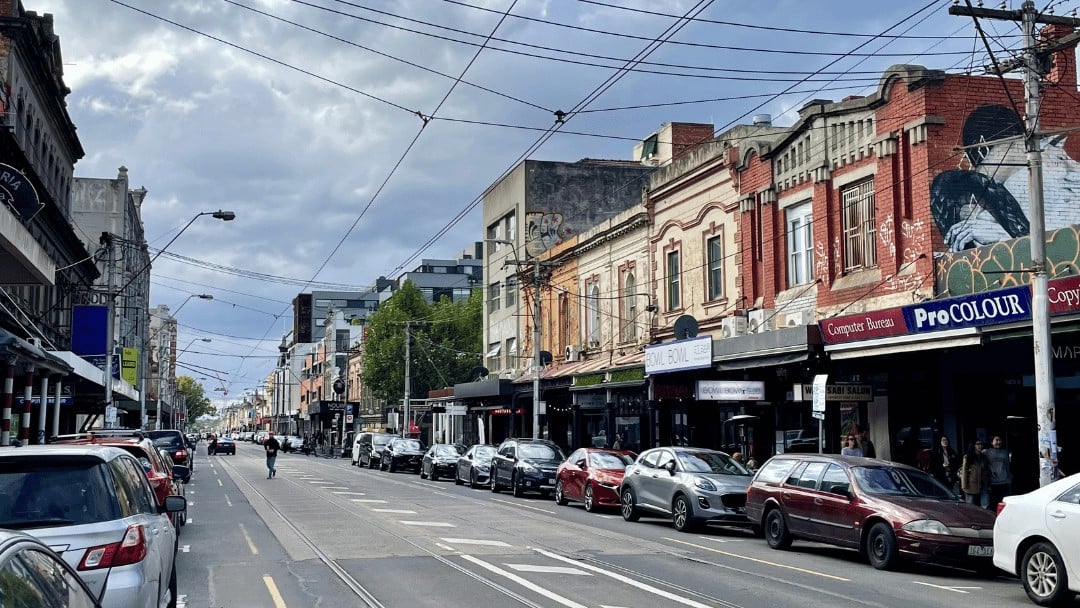Overview
We have transitioned from a hot seller’s market into a reasonably balanced market if anything erring towards a buyer’s market. However, the market has proven extremely resilient, and whilst property growth has slowed there has been no property crash and the market is certainly not flooded with distressed properties for sale.
If you watch the TV, listen to the radio or read the news you will know that the rising cost of living and the increase in interest rates is affecting the market or at the very least buyer’s confidence with all the doom and gloom reporting. However, is it all doom and gloom and is a property crash imminent?
No. Absolutely not.
Despite high inflation and rising interest rates (specifically to bring inflation down), our economic long-term fundamentals are solid and the economic outlook is still very encouraging.
Many markets across Melbourne and indeed across most other capital cities have corrected themselves as can be seen in the chart by CoreLogic. However, at a micro-level, markets are fragmented and there are plenty of areas that are still performing well and experiencing growth.
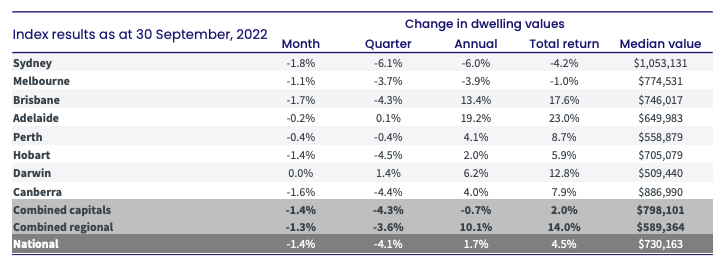
CoreLogic Home Value Index End of September 2022
We need to recognise that the real estate market is coming off the back of a huge growth period and that near 0% interest rates were never sustainable for the long-term and were brought in to assist a country fighting a pandemic. However, now the RBA is attempting to fight rising inflation by making us tighten our belts and reduce our spending.
The quarter ended with interest rates on 2.45%, and the rise to that number might feel sharp, however, historically 2.45% isn’t that high. I understand that no one wants less money in their pocket but as you can see from the below chart, the current interest rate set by the Reserve Bank is still fairly low compared to historically. And for some of us that were old enough to be in the property market in the 1990s, interest rates were as high as 17.5%!
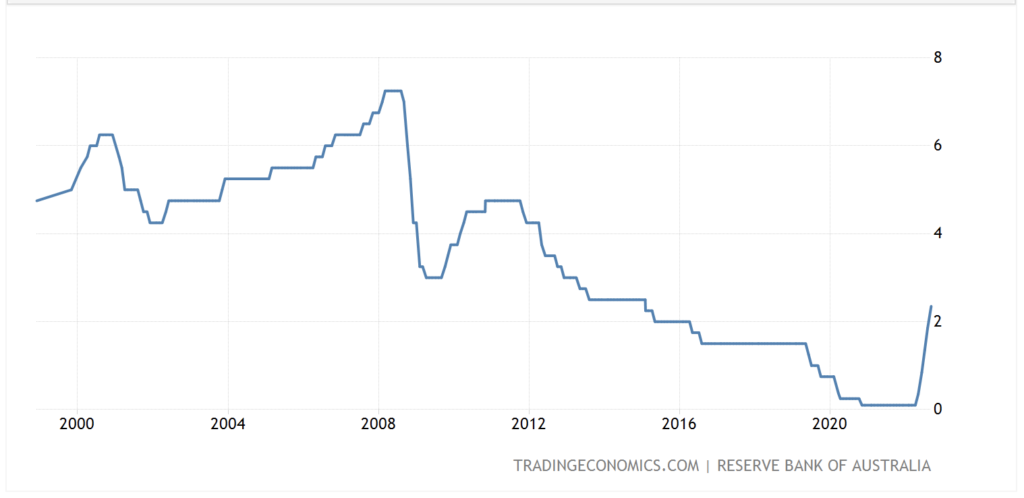
RBA Interest Rates Source: tradingcconomics.com
For new borrowers, their capacity to borrow has been reduced as banks are required to assess loans with a minimum interest rate buffer of 3.0 percentage points above the loan product rate. With borrowing capacity reduced logically, people’s budget for housing is reduced.
The Reserve Bank’s inflation target rate is 2-3%, on average and in August the Australian Bureau of Statistics (ABS) reported that the annual Australian inflation rate was 6.1%. The Reserve Bank has advised that further interest rate rises are likely with predictions that the inflation rate will peak at the end of this year.
We are currently experiencing a small uplift in clearance rates with them sitting around the 70th percentile as can be seen in the below REIV chart. Clearance rates typically at this level reflect a balanced market, one that is not heavily in favour of the seller or buyer.
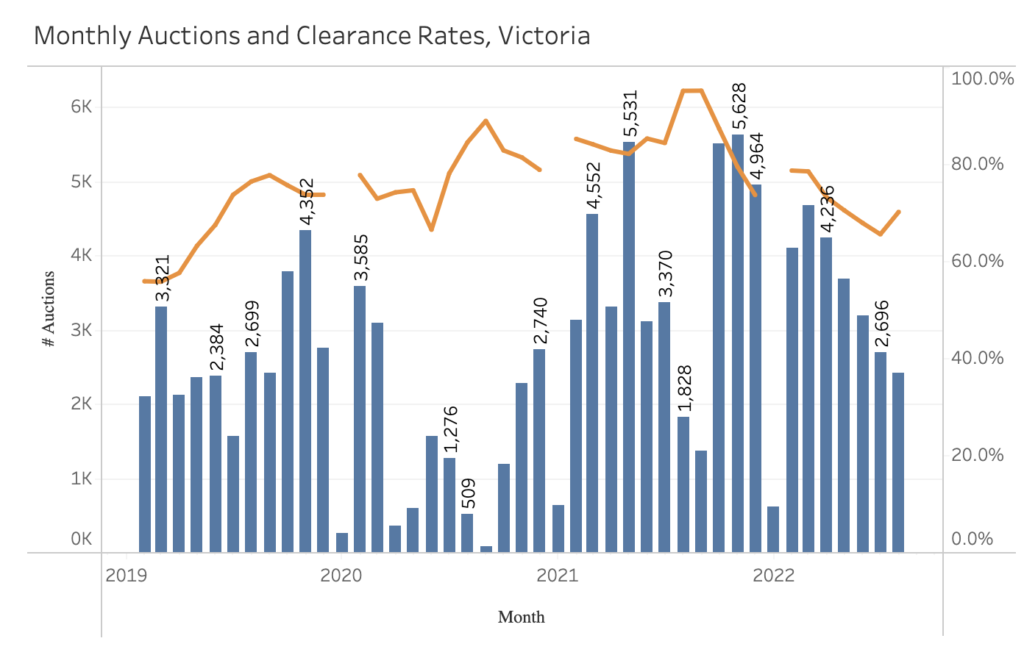
REIV Auction Market Victoria
We have noticed an increase in properties passing in at auction and being concluded and sold behind closed doors. Auctions we attend typically have 2 to 3 bidders and at times the competition just isn’t quite strong enough to push all properties past their reserve. Vendors with price expectations in line with current market conditions are still achieving sales at or shortly after auction.
One of the contributors to the Melbourne market remaining in a balanced position is supply.
Whilst buyer demand has reduced as consumer confidence has slipped and the overall cost of living has increased, vendors are also uncertain and a little more reluctant to list and sell their properties. This means fewer properties are available and this is keeping the market balanced as buyer demand continues to soak up A-grade listings, particularly in popular or gentrifying suburbs.
Low stock levels also indicate the market is not flooded with distressed properties so whilst some borrowers may be feeling the pinch of the increased cost of living, there is certainly not a large number suffering sudden mortgage distress.
There are always winners and grinners and there is plenty of opportunity in the current market. Buyer cohorts such as upgraders, movers and downsizers who potentially have acquired equity in the past and have to borrow less money are more sheltered from the rising interest rate environment.
Buyers that are upsizing their family homes or downsizing are more than likely to be in a good position to benefit from the growth their existing properties have experienced in the last 5 years or so.
While first-home buyers, who typically have to borrow a greater percentage of a property’s value, are adjusting their budgets due to their reduced borrowing capacity, they do remain consistently active with government incentives enticing them and the reduced buyer pool allowing them to compete.
For investors, rents are rising fast at the moment, and yields are consistently improving, in particular in the Melbourne apartment and unit markets. The rental market is extremely tight, with vacancy rates very low and its likely demand will continue to increase as overseas migration numbers continue to increase. With some property markets across Melbourne correcting more than others depending on location and type of property, it is important to remember that investing in real estate simply requires buyers to follow the fundamentals that point to growth. Fundamentals such as supply versus demand at a micro level; population growth, infrastructure – in place and planned, demographics, gentrification and yields, to name a few.
Looking forward
The economists at the banks will probably continue with their somewhat outlandish predictions, and that will continue to result in both buyers and sellers being cautious over the next quarter.
However, despite high inflation and interest rates going up, our economic long-term fundamentals are solid and the economic outlook is still very encouraging. We are enjoying our first Spring in 3 years not affected by COVID-19 restrictions and we are all enjoying the freedoms (sensibly) and the consistency this brings to the housing market.
While interest rates have risen and the overall cost of living has impacted affordability generally, we are expecting many sectors of the Melbourne property market to remain in a balanced state. We have transitioned from a hot seller’s market into a balanced market, and it’s likely to remain balanced as stock levels remain low.
In times like these, to generate wealth through capital growth, it’s vitally important to remember the fundamentals of investing in property and that it is not necessary that you try and “time” the market. It’s much more important to buy an A-grade property and have the mentality of “time in the market” rather than “timing the market”.
"Worth a Second Look”
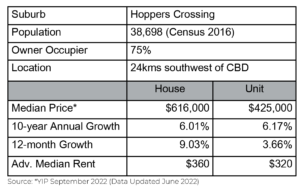 Overview
Overview
With over 1,000 suburbs in Greater Melbourne, you would expect some variety. Last quarter we reviewed Hampton East, a suburb 14kms southeast from the CBD with a $1.535m median house price, this quarter we are reviewing Hoppers Crossing, a suburb 24kms southwest of the CBD with a median house price of $627,944!
Hoppers Crossing is part of the City of Wyndham which is one of the fastest-growing municipalities in Australia. Home to more than 288,000 residents, the population is expected to reach 440,000 by 2040. As one of the fully developed land suburbs Hoppers Crossing is currently contributing approximately 37,000 residents to the city.
With its large population, it won’t surprise you that it has a thriving shopping and community district, with schools, leisure centres, parks and sporting clubs. And if Hoppers Crossing doesn’t have it then its next-door neighbour Werribee does, including universities, hospitals and a large shopping centre.
Transport
Hoppers Crossing is well located between the city and Geelong. It will take you about 30 minutes to drive to the CBD on the M1 during non-peak traffic or you can catch a train on the Werribee Line to the Hoppers Crossing or Werribee Train Station in about 40 minutes. You are also approximately 30 minutes away from the Tullamarine and Avalon airports.
Congestion has been eased around the Hoppers Crossing Train station with the completion of the rail crossing removal late last year and peak hour traffic congestion on the West Gate Bridge should be eased by the West Gate Tunnel project scheduled to be completed during 2023.
There is a second station nearby in Tarneit on the Vline train that runs through Geelong to Warrnambool. Under the Andrews State Government, it has been flagged as becoming part of the metropolitan railway network under the Western Rail Plan.
Shops
Just a short distance from the Hoppers Crossing Train Station is the Hoppers Crossing Shopping Centre which has a large Coles, fresh food, cafes, dining, pharmacies and postal services. There are further shopping options on Old Geelong Road or Hogan’s Shopping Centre which has 19 stores.
Or you can head to Pacific Werribee which has 300+ stores, a cinema and a dining precinct.
Education
There are a large number of government and independent primary and secondary schools within a short distance of homes in Hoppers Crossing.
The University of Melbourne and Victoria University have campuses next door in Werribee.
Parks
There are a number of parks and playgrounds and the most well-known walking and cycling trials are around Skeleton Creek and the Federation Trial. There are tennis courts, cricket and football clubs. The leisure centre, AquaPulse provides indoor aquatics and gym facilities.
Houses
Hoppers Crossing is one of the largest Melbourne suburbs and is one of the few remaining suburbs that offers you the ability to purchase a house on land for under $650,000 that is liveable or rentable as is.
We prefer properties that are south of Hogan Road as they offer good access to the train station, the freeway, schools, Werribee Plaza and medical facilities.
The Wyndham Council has identified the Hoppers Junction precinct as a pivotal location for a new urban centre that has the potential for encouraging more development, improved urban amenities such as better public spaces, parks, and services, and more employment and business opportunities so Hoppers Crossing is definitely a suburb to be watched or invested in!
Off-market secured with Tenants

by Antony Bucello
Director
Antony is married with 2 children and lives in Lower Templestowe, Victoria. Educated at Swinburne University, his sales and marketing career has spanned over 30 years in both the Financial Services and Property sectors. Having been involved in countless property purchases for his clients over the years, he is now a leading Melbourne Buyer Advocate and his expertise has been recognised by multiple award nominations including being a finalist for Buyer Agent of the Year by Your Investment Property Magazine, REB and REIV. 0418 131 950 or email.
Contact Us Today
If you have any questions about the Melbourne market don’t hesitate to contact our local team or if you would like a complimentary, obligation free 1 hour consultation please complete this form.

